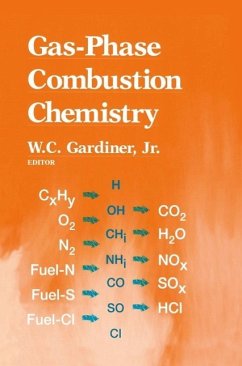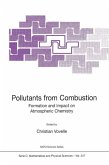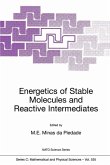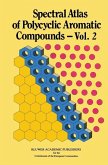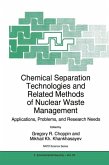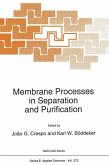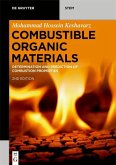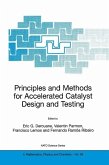Gas-Phase Combustion Chemistry (eBook, PDF)
Redaktion: Gardiner, W. C.
105,95 €
105,95 €
inkl. MwSt.
Sofort per Download lieferbar

53 °P sammeln
105,95 €
Als Download kaufen

105,95 €
inkl. MwSt.
Sofort per Download lieferbar

53 °P sammeln
Jetzt verschenken
Alle Infos zum eBook verschenken
105,95 €
inkl. MwSt.
Sofort per Download lieferbar
Alle Infos zum eBook verschenken

53 °P sammeln
Gas-Phase Combustion Chemistry (eBook, PDF)
Redaktion: Gardiner, W. C.
- Format: PDF
- Merkliste
- Auf die Merkliste
- Bewerten Bewerten
- Teilen
- Produkt teilen
- Produkterinnerung
- Produkterinnerung

Bitte loggen Sie sich zunächst in Ihr Kundenkonto ein oder registrieren Sie sich bei
bücher.de, um das eBook-Abo tolino select nutzen zu können.
Hier können Sie sich einloggen
Hier können Sie sich einloggen
Sie sind bereits eingeloggt. Klicken Sie auf 2. tolino select Abo, um fortzufahren.

Bitte loggen Sie sich zunächst in Ihr Kundenkonto ein oder registrieren Sie sich bei bücher.de, um das eBook-Abo tolino select nutzen zu können.
Superseding Gardiner's "Combustion Chemistry", this is an updated, comprehensive coverage of those aspects of combustion chemistry relevant to gas-phase combustion of hydrocarbons. The book includes an extended discussion of air pollutant chemistry and aspects of combustion, and reviews elementary reactions of nitrogen, sulfur and chlorine compounds that are relevant to combustion. Methods of combustion modeling and rate coefficient estimation are presented, as well as access to databases for combustion thermochemistry and modeling.
- Geräte: PC
- ohne Kopierschutz
- eBook Hilfe
- Größe: 44.3MB
Andere Kunden interessierten sich auch für
![Pollutants from Combustion (eBook, PDF) Pollutants from Combustion (eBook, PDF)]() Pollutants from Combustion (eBook, PDF)161,95 €
Pollutants from Combustion (eBook, PDF)161,95 €![Energetics of Stable Molecules and Reactive Intermediates (eBook, PDF) Energetics of Stable Molecules and Reactive Intermediates (eBook, PDF)]() Energetics of Stable Molecules and Reactive Intermediates (eBook, PDF)73,95 €
Energetics of Stable Molecules and Reactive Intermediates (eBook, PDF)73,95 €![Spectral Atlas of Polycyclic Aromatic Compounds (eBook, PDF) Spectral Atlas of Polycyclic Aromatic Compounds (eBook, PDF)]() Spectral Atlas of Polycyclic Aromatic Compounds (eBook, PDF)73,95 €
Spectral Atlas of Polycyclic Aromatic Compounds (eBook, PDF)73,95 €![Chemical Separation Technologies and Related Methods of Nuclear Waste Management (eBook, PDF) Chemical Separation Technologies and Related Methods of Nuclear Waste Management (eBook, PDF)]() Chemical Separation Technologies and Related Methods of Nuclear Waste Management (eBook, PDF)161,95 €
Chemical Separation Technologies and Related Methods of Nuclear Waste Management (eBook, PDF)161,95 €![Membrane Processes in Separation and Purification (eBook, PDF) Membrane Processes in Separation and Purification (eBook, PDF)]() Membrane Processes in Separation and Purification (eBook, PDF)233,95 €
Membrane Processes in Separation and Purification (eBook, PDF)233,95 €![Combustible Organic Materials (eBook, PDF) Combustible Organic Materials (eBook, PDF)]() Mohammad Hossein KeshavarzCombustible Organic Materials (eBook, PDF)89,95 €
Mohammad Hossein KeshavarzCombustible Organic Materials (eBook, PDF)89,95 €![Principles and Methods for Accelerated Catalyst Design and Testing (eBook, PDF) Principles and Methods for Accelerated Catalyst Design and Testing (eBook, PDF)]() Principles and Methods for Accelerated Catalyst Design and Testing (eBook, PDF)161,95 €
Principles and Methods for Accelerated Catalyst Design and Testing (eBook, PDF)161,95 €-
-
-
Superseding Gardiner's "Combustion Chemistry", this is an updated, comprehensive coverage of those aspects of combustion chemistry relevant to gas-phase combustion of hydrocarbons. The book includes an extended discussion of air pollutant chemistry and aspects of combustion, and reviews elementary reactions of nitrogen, sulfur and chlorine compounds that are relevant to combustion. Methods of combustion modeling and rate coefficient estimation are presented, as well as access to databases for combustion thermochemistry and modeling.
Dieser Download kann aus rechtlichen Gründen nur mit Rechnungsadresse in A, B, BG, CY, CZ, D, DK, EW, E, FIN, F, GR, HR, H, IRL, I, LT, L, LR, M, NL, PL, P, R, S, SLO, SK ausgeliefert werden.
Produktdetails
- Produktdetails
- Verlag: Springer US
- Seitenzahl: 543
- Erscheinungstermin: 6. Dezember 2012
- Englisch
- ISBN-13: 9781461213109
- Artikelnr.: 44176104
- Verlag: Springer US
- Seitenzahl: 543
- Erscheinungstermin: 6. Dezember 2012
- Englisch
- ISBN-13: 9781461213109
- Artikelnr.: 44176104
- Herstellerkennzeichnung Die Herstellerinformationen sind derzeit nicht verfügbar.
1. Combustion Chemistry Modeling.- 1.1. Introduction.- 1.2. Oxidation of hydrogen and carbon monoxide.- 1.3. Hydrocarbon combustion chemistry.- 1.4. Nitrogen, sulfur, and halogens in flames.- 1.5. Combustion of alternative fuels.- 1.6. Combustion inhibitors.- 1.7. Combustion promoters.- 1.8. Reduced chemistry models of combustion.- 1.9. Resources for combustion chemistry modeling.- 1.10. References.- 2. Combustion Chemistry of Nitrogen.- 2.1. Introduction.- 2.2. Overview of nitrogen chemistry.- 2.3. Unimolecular and chemically activated bimolecular reactions.- 2.4. Analysis of hydrogen atom abstraction reactions.- 2.5. Updated rate coefficients for the H/N/O system.- 2.6. QRRK treatments.- 2.7. Other reactions of interest.- 2.8. Illustrative modeling results.- 2.9. Summary.- 2.10. Acknowledgments.- 2.11. References.- 3. Kinetics and Mechanisms of the Oxidation of Gaseous Sulfur Compounds.- 3.1. Introduction.- 3.2. Sulfur emissions.- 3.3. Elementary reactions.- 3.4. Basic chemistry of sulfur in combustion environments.- 3.5. Thermochemistry of sulfur-containing compounds.- 3.6. Observations and conclusions.- 3.7. Acknowledgments.- 3.8. References.- 4. Survey of Rate Coefficients in the C-H-Cl-O System.- 4.1. Introduction.- 4.2. Electronic structure and thermochemistry.- 4.3. Characteristic features of elementary reactions of chlorine.- 4.4. Reaction mechanisms.- 4.5. Survey of elementary reactions.- 4.6. Data gaps and suggestions for future work.- 4.7. Acknowledgments.- 4.8. References.- 5. Ideal Gas Thermochemical Data for Combustion and Air Pollution Use.- 5.1. Introduction.- 5.2. Thermochemical database.- 5.3. Sources of thermochemical data.- 5.4. Thermochemical polynomials.- 5.5. Calculation procedures.- 5.6. Accuracy of the database.- 5.7. Accuracy of standard enthalpies of formation.- 5.8. Other sources of thermochemical data.- 5.9. Format of the database.- 5.10. Conversion factors.- 5.11. Internet transfer of the database.- 5.12. References.- 5.13. Table of standard enthalpies of formation.
1. Combustion Chemistry Modeling.- 1.1. Introduction.- 1.2. Oxidation of hydrogen and carbon monoxide.- 1.3. Hydrocarbon combustion chemistry.- 1.4. Nitrogen, sulfur, and halogens in flames.- 1.5. Combustion of alternative fuels.- 1.6. Combustion inhibitors.- 1.7. Combustion promoters.- 1.8. Reduced chemistry models of combustion.- 1.9. Resources for combustion chemistry modeling.- 1.10. References.- 2. Combustion Chemistry of Nitrogen.- 2.1. Introduction.- 2.2. Overview of nitrogen chemistry.- 2.3. Unimolecular and chemically activated bimolecular reactions.- 2.4. Analysis of hydrogen atom abstraction reactions.- 2.5. Updated rate coefficients for the H/N/O system.- 2.6. QRRK treatments.- 2.7. Other reactions of interest.- 2.8. Illustrative modeling results.- 2.9. Summary.- 2.10. Acknowledgments.- 2.11. References.- 3. Kinetics and Mechanisms of the Oxidation of Gaseous Sulfur Compounds.- 3.1. Introduction.- 3.2. Sulfur emissions.- 3.3. Elementary reactions.- 3.4. Basic chemistry of sulfur in combustion environments.- 3.5. Thermochemistry of sulfur-containing compounds.- 3.6. Observations and conclusions.- 3.7. Acknowledgments.- 3.8. References.- 4. Survey of Rate Coefficients in the C-H-Cl-O System.- 4.1. Introduction.- 4.2. Electronic structure and thermochemistry.- 4.3. Characteristic features of elementary reactions of chlorine.- 4.4. Reaction mechanisms.- 4.5. Survey of elementary reactions.- 4.6. Data gaps and suggestions for future work.- 4.7. Acknowledgments.- 4.8. References.- 5. Ideal Gas Thermochemical Data for Combustion and Air Pollution Use.- 5.1. Introduction.- 5.2. Thermochemical database.- 5.3. Sources of thermochemical data.- 5.4. Thermochemical polynomials.- 5.5. Calculation procedures.- 5.6. Accuracy of the database.- 5.7. Accuracy of standard enthalpies of formation.- 5.8. Other sources of thermochemical data.- 5.9. Format of the database.- 5.10. Conversion factors.- 5.11. Internet transfer of the database.- 5.12. References.- 5.13. Table of standard enthalpies of formation.
